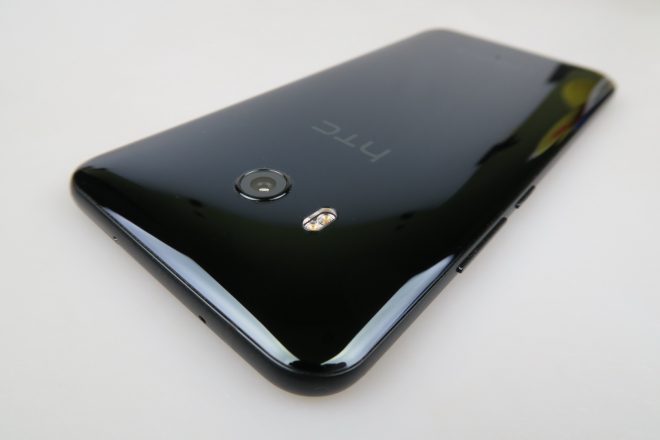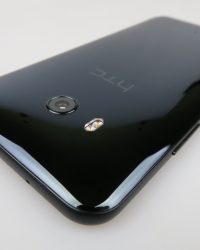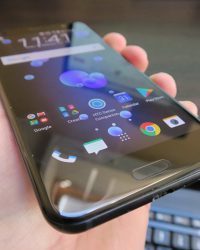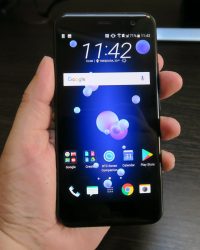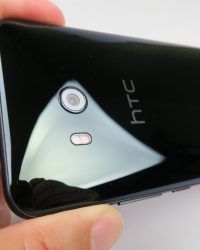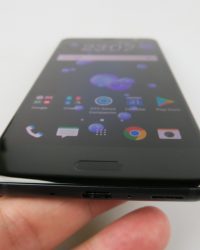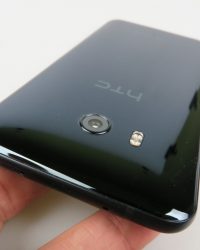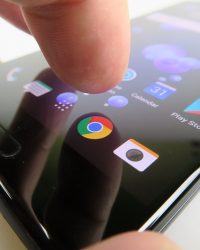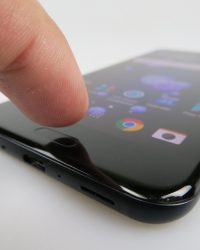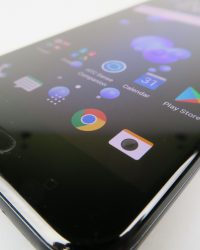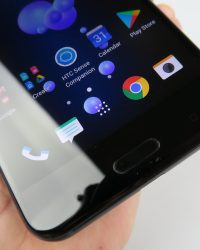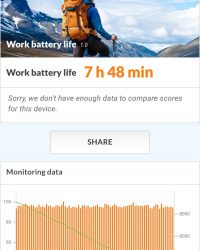HTC 10 was an excellent phone last year, but it had its shortcomings, like the battery or screen brightness. It’s up for the successor to fix it, but aside from doing that, HTC U11 also throws in some welcome extras, like the very famous already Edge Sense. We looked into it ourselves and reviewed the device below. It’s priced at $649 and we handled it just as it was launched in May this year.
Made of glass and metal, the device is a Snapdragon 835 flagship and it was actually our first contact with this CPU. The handset comes with premium headphones, a case and a cleaning cloth for the glass. This is no regular phone, as it proudly sits on top of the DxOMark testing list. Design-wise, the HTC U11 is an evolution from the HTC U Ultra and U Play as the phone becomes more compact, easier to manage and handle.
It’s made of glass and metal, using a type of glass called 3D Liquid Surface. It’s truly amazing the way it catches light and reflects it. The phone is now dust and water resilient, within the IP67 standard. It also has a solid metal frame and measures 7.9 mm in thickness, which is 0.1 mm less than HTC U Ultra and 0.6 mm more than the iPhone 7 Plus. We’re dealing with a 5.5 incher here, that weighs 169 grams, clearly lighter than the iPhone 7 Plus, but also too close to the U Ultra’s 170 grams for comfort.
I have to say that this device is a bit slippery, especially the back side. Also, the black version is a certain fingerprint magnet. HTC U11 is available in silver, blue, black, white or red and it’s quite a wide machine, so it’s hard to use with one hand. This is a polarizing design, that will get some people to love it and others to hate it. I just like the way it reflects light…
Moving on to the screen, we’ve got a 5.5 incher here, with 3D glass upfront and a Super LCD 5 panel. It provides a Quad HD resolution and Gorilla Glass 5 protection. A 71.4% screen to body ratio is in the mix, a far cry from from the 80% that other flagships achieve. The viewing experience involves good brightness, vivid colors (but less than an AMOLED), wide view angles and an OK contrast, even in sunlight.
Pixels have an RGB Stripes arrangement and the luxmeter showed us a value of 409 LUX, which is just OK for a flagship. It’s below the iPhone 7 and Nexus 6P, as well as the Huawei P10, but it beats the LeEco Le Max 2 and Galaxy Note 4. Settings for this screen include a Glove Mode, font size, item size, auto brightness, color temperature (warmer or colder), plus there’s a Night Mode with a color temperature slider.
Finally, we’ve got a nav button option and overall this is a good screen, but no record breaker. Moving on to other hardware, the top of the line Snapdragon 835 CPU rests inside the phone, accompanied by the Adreno 540 GPU, 4 GB of RAM and 64 GB of storage. There’s also a microSD card slot. HTC U11 doesn’t suffer from lag and has a fluid UI, throughout the usage experience.
Apps start up fast and the game Riptide GP Renegade ran like a champ. We also performed a few benchmarks, like Quadrant, where we placed above the LG G5 and below the HTC 10. In AnTuTu 6 we scored second place, below the iPhone 7 Plus and above the Galaxy S8 though. In GeekBench 4 were only slightly below the Galaxy S8 in the multi core sub test.
In 3DMark Ice Storm Unlimited we took first spot and also in BaseMark X, so results are solid all around, Vellamo too. These results are great and this is one of the most powerful phones on the market for sure. As far as temperature goes, after running GFXBench we got to 34.6 degrees Celsius and after running Riptide GP Renegade we got to 37.1, so there’s no overheating here.
On the battery front, there’s a 3000 mAh unit in the mix here, with Quick Charge 3.0 and the promise on paper of up to 14 days of standby, or 24.5 hours of talk time. Leaving aside the paper, we did our own tests and achieved 11 hours and 41 minutes of continuous HD playback, which is quite good and it’s basically one full season of Netflix.
This beats the ASUS ZenFone 3 and Galaxy S6 Edge+, but scores below the iPhone 7 and Pixel XL. In PCMark we scored 7 hours and 48 minutes, but I frankly expected more than that, even though this time is quite OK. It’s superior to the Xiaomi Mi 5 and Huawei P10, but inferior to the Galaxy S8 and Pixel XL. Charging is done in 1 hour and 47 minutes, which is once again reasonable and the equal of the Huawei P10 Plus.
One of my interesting findings was that after one hour of listening to music on YouTube via headphones we lost 30% battery life (screen on), so that’s not good news. I have to say that brightness was at 100%. We also did a step by step charging test, achieving 8% after 5 minutes, 25% after 15 minutes and 46% after 30 minutes. One hour means 79%.
Settings include functions like Optimization, Power Saver (limit CPU, vibration and brightness), plus there’s also Extreme Power Save, that lets you just use the basic features. At least the HTC 10 results have improved. Moving to the acoustics, we’ve got a top and bottom speaker here, the tp one being the tweeter and the bottom one the woofer. BoomSound tech is also here, with a Music Mode and Theater Mode available.
The Music Mode offers better highs and mids. No EQ has been included here. When listening to tunes we achieved a very high volume, perfect bass and great highs. The voice was solid. The decibelmeter showed us 89.3 dBA at the front and bottom and 79.5 dBA at the front and top. Those happened with an acoustic sample, while Riptide GP renegade brought us 94.6 dBA, but I have to admit that in real life it sounds more like 100 dBA.
The conclusion? Superior to the HTC 10 in the first test and the HTC U Ultra, but inferior in the second. The Galaxy S8 was also surpassed, slightly. High emphasis has been put by HTC on its Usonic headphones, that are a premium proposition. They’re perfectly comfy, loud but not deafening like other modern headsets and USonic also has the advantage of a functionality that maps the inner ear and delivers a customized acoustic experience.
Hi Res acoustics are also on offer here. Perfect noise cancelling is another plus and I’d say that these headphones are either on par with the ones from the Galaxy S8, or even better. These are all $100 plus headsets, as far as I know. Moving on to the camera, this is no regular shooter, as it has been awarded by DxOMark with the first spot in its top.
HTC 10 was the landmark for 6 months and now it’s time for a new champ. At the back of the HTC U11 rests a 12 MP camera with HTC Ultrapixel 3 technology, 1.4 micron pixels, ultra speed autofocus, BSI sensor and optical image stabilization. It also offers F/1.7 aperture, 4K video and 3D audio. A dual LED flash is also in the mix. The front camera is a 16 MP unit with F/2.0 and BSI.
The camera app is pretty typical, if you’ve seen the HTC U Ultra review. The camera offered very fast focus and also very fast picture taking, even compared to other flagships. The zoom works in fluid fashion and we get the same options as on the HTC U Ultra. There’s aspect, timer, panorama and a Pro mode, with options like white balance, ISO, exposure, shutter and focus, plus RAW capture.
The video lets you do some acoustic focus, hyperlapse, slow mo and then there’s Selfie, with its 3 branches: Photo, Panorama and Video. We move on to the gallery (day time 1), where we achieved some great results on a torrid day that combines clouds and sun. Hues were flawless and we had a great texture of the flowers we photographed. Panorama is 12.346 x 1450 pixels in resolution here, quite big I’d say.
You can zoom in all you want, because the details are good either way. HDR is quite discrete and focus and lighting are pefect. We photographed some of the best looking clouds I’ve seen caught digitally, which is hard to do on 35+ degree Celsius weather. Sadly, the selfies were a bit underwhelming, but honestly I expected it, because the HTC U Ultra was also a letdown in the field.
I feel that this 16 MP sensor produces lesser results than the iPhone 7 or Galaxy S8. Back to the main camera (day time gallery 2), the dynamic range was well calibrated and the hue of green was one of the best I’ve seen. It’s superior to the Huawei P10 Plus for sure, because that one didn’t calibrate greens correctly. HDR is good, the zoom works great and I feel that this model can fight any flagship on equal turf, Galaxy S8 included and Google Pixel too.
It simply can’t fail and feels superior to the HTC U Ultra, plus the HTC 10. It beats the Huawei P10 as well. Low light capture was very bright (gallery here) and while some of the phones I’ve used barely show that red hydrant when the flash is off, this one actually reveals a ton of details. I even liked the zoomed in shots, which usually look poor during the night on most devices.
Street light halos have a reasonable size, so no objection here. I find that the pics are a bit more yellow than on the Pixel XL, that was more pragmatic with night time shots. I feel the need to highlight again the fact that these shots are very and I mean very bright for low light. Even brighter than the Galaxy S8 I’d say. You get day like clarity and this has got to be the HTC phone ever when it comes to this type of capture.
Now on the video front, there’s 4K here at 55 Mbps and we get excellent focus and exposure change. Clarity is quite good and sometimes I felt that the exposure change was aggressive when switching from shade to light and viceversa. I loved the microphone and the fact you can zoom into an orchestra and highlight each instrument separately. Zooming in will drop some details, to be honest and the colors were quite vivid, actually almost oversaturated at times.
Since I’m starting to mention drawbacks, the stabilization could be better and I’d like more stable videos. Some image curving happens and the second batch of videos we did was a bit dark to be honest. However, colros were closer to the standard there. There’s an annoying effect that appeared, with shakes and curves appearing on the screen when zooming in. I’d say that object tracking was good and just as a quick mention HTC 10 had optical image stabilization for the front camera, but HTC U11 doesn’t.
As you can see, we kept repeating words like “excellent” or “perfect” for photo capture, but video… not that much. HTC U11 feels like it’s more of a Huawei P10 rival in the video area, rather than Galaxy S8. Google Pixel XL also feels superior in my book. Things to remember here are the microphone, which is fantastic and the clarity, where there’s zero problems.
Stabilization and some flicker did tend to spoil the fun. Low light video capture was rather yellow, halos were big and we registered some motion blur. At least the lighting was solid and panning was also quite OK. When walking around you’d expect some decent stabilization, but instead the image vibrates, as if a giant being was approaching.
In spite of the above critique, the HTC 10 was not much better, so we actually improved on it. Overall, the bump from the HTC 10 is here, but not in all areas. The selfie is one of them, for example. We did a web browser test via Chrome, which proved to be quite fast. Benchmarks are good and the virtual keyboard, which we also tested had big keys and comfy ones too.
On the connectivity front, there’s no audio jack, so let’s get that out of the way. There’s an USB Type-C port and the device comes in a single SIM or dual SIM version. There’s VoLTE and WiFi calling, 4G LTE Category 16 (up to 1 Gbps on paper), NFC, Bluetooth 4.2, WiFi a/b/g/n/ac, Chromecast, DLNA, Airplay and Miracast. Calls are loud and clear and we’ve got great noise cancelling.
We also did a SpeedTest and achieved 88 Mbps in download speed on 4G and 27 Mbps in upload. On WiFi it’s 216 Mbps download and 25 Mbps in upload. Time to talk about the OS, UI and apps. We’re running on Android 7.1 Nougat with HTC Sense on top and you’re probably wondering how is it that you’ve read such a huge review and still no info about HTC Edge Sense.
This feature lets you squeeze the sides of the device in order to start the camera, the virtual assistant or some other app or feature. The best thing about it is that it lets you trigger the camera underwater and actually take pics with it. The squeeze can be set up with various pressure levels and you can also choose which app to trigger. You can take a screenshot, record voice and more, much more.
Also, you can squeeze with the screen on or off, in case you’re wondering. Then there’s the extra gesture: you can do a short squeeze or a squeeze and hold, each with its own associated apps and features. I can only say it works and you get used to it fast, but you could live without just well, especially if you’re not a swimmer. The leftmost homescreen is still dedicated to Highlights from social networks, Calendar and even meal recommendations.
Keep the homescreen pressed and you’ll tweak the theme, widgets and more. HTC lets you customize the experience a lot, with icons, widgets that can be expanded all over the screen and a variety of choices. The typical green, grey and white UI is here. Settings of the device include on body detection, personalization and the fingerprint scanner.
That one is embedded within the Home button and it requires a 17 step setup. The screen unlock is fast, at least. HTC Sense Companion is here, like on the HTC U Ultra, but sadly it’s still not as smart as Alexa, Siri or Google Assistant. It’s more of a discrete helper, that shows hints via green windows at the top of the screen. It tells you to take an umbrella, sports scores, call someone who called before and other such things.
As far as apps go, we get 41 apps preinstalled here, the most useful of which is Boost+, that cleans junk and does some power optimization. Instagram and Under Armour are also here, plus Zoe Video Editor. At least you can uninstall any app you want. And now it’s time for the verdict!
Here are the Pros:
- great audio
- nice design
- good display
- stellar performance
- great pictures
- good connectivity
- supports multiple virtual assistants
- nice UI
- activate apps and features underwater with Edge Sense
- directional audio capture
And the Cons
- continuous usage could be better (battery)
- slippery
- not impressive selfies
- stabilization isn’t up to expectations
- night time video doesn’t feel like flagship material
- Edge Sense is in the end a gimmick
- Sense Companion isn’t hugely useful
In the end, HTC U11 is an upgrade from the HTC 10, in areas like audio, battery, design and pictures. It may take inferior selfies and videos, but there’s more innovation and personality here. Perfomance-wise it’s hard to do better and the design is certainly unique. And then there’s the audio aspect, which makes this a killer music player. What’s for sure is that this is the best HTC phone money can buy right now.
You can buy one here.



